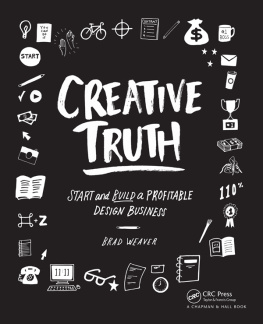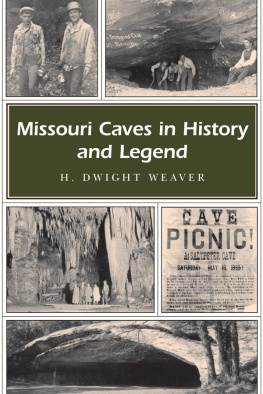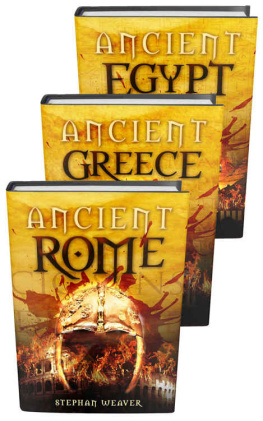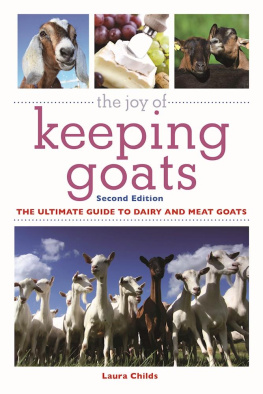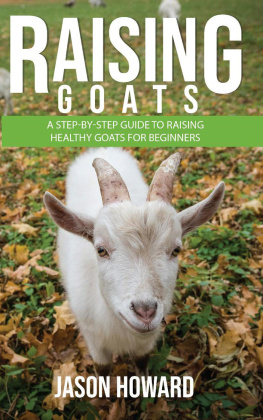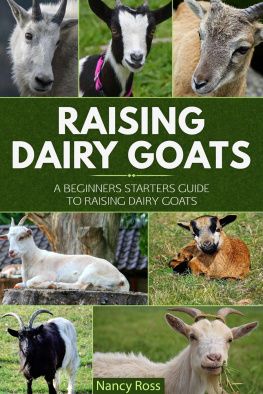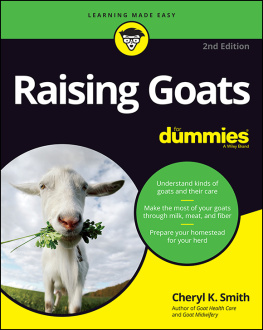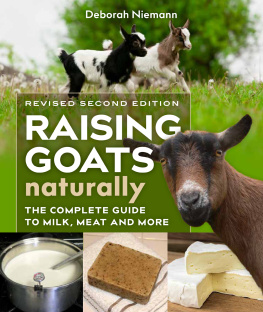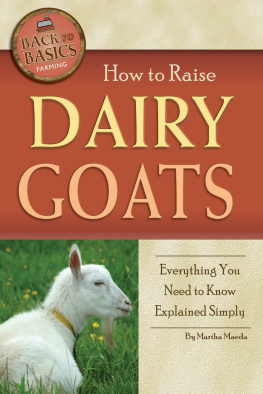The BACKYARD
GOAT
The BACKYARD
GOAT
An Introductory Guide to Keeping Productive Pet Goats
Sue Weaver

The mission of Storey Publishing is to serve our customers by
publishing practical information that encourages
personal independence in harmony with the environment.
Edited by Sarah Guare and Deborah Burns
Art direction and book design by Cynthia McFarland
Book layout by Karin Stack
Text production by Jennifer Jepson Smith
Cover and part opener illustrations by Jing Jing Tsong, Jing and Mike Company
Pen & ink illustrations by Elayne Sears
Back cover photograph by John and Melody Anderson
Author photograph by John Weaver
Interior photography credits appear on page 206
Indexed by Christine R. Lindemer, Boston Road Communications
2011 by Sue Ann Weaver
All rights reserved. No part of this book may be reproduced without written permission from the publisher, except by a reviewer who may quote brief passages or reproduce illustrations in a review with appropriate credits; nor may any part of this book be reproduced, stored in a retrieval system, or transmitted in any form or by any means electronic, mechanical, photocopying, recording, or other without written permission from the publisher.
The information in this book is true and complete to the best of our knowledge. All recommendations are made without guarantee on the part of the author or Storey Publishing. The author and publisher disclaim any liability in connection with the use of this information.
Storey books are available for special premium and promotional uses and for customized editions. For further information, please call 1-800-793-9396.
Storey Publishing
210 MASS MoCA Way
North Adams, MA 01247
www.storey.com
Printed in the United States by Versa Press
10 9 8 7 6 5 4 3 2 1
LIBRARY OF CONGRESS CATALOGING-IN-PUBLICATION DATA
Weaver, Sue.
The backyard goat / by Sue Weaver.
p. cm.
Includes index.
ISBN 978-1-60342-790-6 (pbk. : alk. paper)
1. Goats. I. Title.
SF383.W33 2011
636.39dc22
2010051170
Dedication
For MAC Goats Chief Forty-Five (Chiefee)
you were a neat old goat.
And for Claudia Marcus-Gurn
and Emily Dixon,
who put good goats in my life.
Contents
Preface
My love affair with goats began later in my life, relatively speaking. My first love was horses. In fact, my mother says my first word was horse. Over the years Ive shown, bred, and trained horses. I spent countless dollars buying and supporting the equine critters I dearly loved. I kept goats, because horses and goats go together like ice cream and pie, but goats werent my life until I met Chiefee.
Several years ago, I was asked to write about goats. As part of the research process, I subscribed to a passel of e-mail lists hosted by YahooGroups. Through them I met two women whose friendships have changed my life: Claudia Marcus-Gurn, of MAC Goats, and Emily Dixon, of Ozark Jewels.
That spring my husband, John, and I visited MAC Goats to collect a couple of three-week-old bottle-baby wethers the Gurns were graciously giving me and to photograph their beautiful Boers. Last stop on our tour of the Gurns goat operation was the buck barn. When we ducked through the door, the biggest, brawniest old goat Id ever seen ambled forward, propped his front feet on the bottom rail of his stall front, and fastened his soulful eyes on mine. In a heartbeat MAC Goats Chief Forty-Five, a.k.a. Chiefee, stole my heart. I knew I had to share my life with goats like him.
First came the bottle babies, Salem and Shiloh, whose mother was half sister to old Chiefee. Then a young buck from one of Chiefees daughters joined our small herd, and before I knew it I owned eleven Boer goats! Soon I discovered packgoats and carting. And through Emily Dixon, I grew to love Nubians for their quirky personalities and yummy milk. Now twenty goats call our Ozark acreage their home, including my Boers, whom I treasure as my link to Chiefee.
And the horse obsession that burned so brightly for more than fifty years? Its still there, but considerably dimmed. I still love my horses, but goats (and sheep) are my passion now. I wouldnt have it any other way.
Part 1
Getting to Know Your Goats


CHAPTER 1 An Introduction to Goats
If the beard meant everything, the goat would preach.
Danish proverb
The goat is among the oldest species domesticated by humans as a food source and for other purposes. Goats played a critical role in the lives of our distant ancestors, and, while their role today is not as widespread or integral to our survival, they still provide food, fiber, transportation, and companionship to countless people around the world. Their small size and grazing nature continue to make them the preferred livestock for the many farmers around the globe who must feed themselves on marginal land. To fully appreciate these special creatures, first learn about their history and how they function and think.
Origins of the Goat
For ancient races, goats were life-sustaining. Goats furnished food and carried packs. Bride prices and dowries were paid in goats, and goats provided sacrifices for the peoples gods. In some cases, goats were the peoples gods, or their gods had goaty attributes such as goats legs and horns. Wealth was reckoned in goats sometimes hundreds and thousands of them. The story of man and goat together is rich and diverse.
Ten thousand years ago, before any other livestock species had been tamed, villagers at Ganj Dareh, high in the Zagros Mountains of what is now Iran, made an alliance with wild goats. Humans would tame, feed, and protect the goats; the goats would, in turn, provide meat, milk, hides, hair, horns, bones, sinew, and dung for fuel.
Archaeological clues discovered at Ganj Dareh show proof of domestication. Goat bones are frequently unearthed at digs made in the Middle East, where hunters stalked wild goats since Neanderthal times. Typical bones recovered from food middens were mostly those of large old bucks. It made sense to target animals that packed the most meat. At Ganj Dareh, however, bones unearthed were mainly those of immature bucks. This, say goat domestication experts Dr. Melinda Zeder, curator of Old World Archaeology and Zooarchaeology at the National Museum of Natural History, and Dr. Brian Hesse, of the University of Alabama, was proof of domestication: does and a few mature bucks were kept for breeding, while extra bucklings and young adult males went into the family larder.
Meet the Bezoar Goat
The goats tamed at Ganj Dareh were Bezoar goats, also known as Bezoar ibexes, pasang, and
Next page

